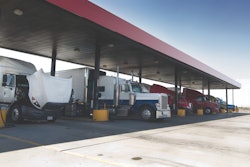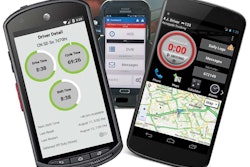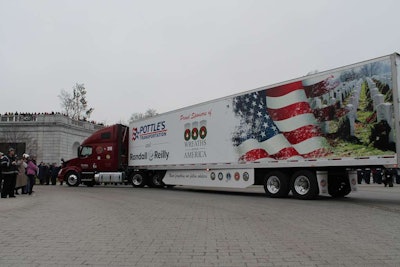 Pottle’s Transportation uses a mobile app to keep drivers connected outside the cab.
Pottle’s Transportation uses a mobile app to keep drivers connected outside the cab.Drivers at Pottle’s Transportation use in-cab devices and applications from Omnitracs for routine work in the cab such as electronic logging and messaging.
About 1.5 years ago, management gave drivers the option to install an app on their personal devices. With the app, drivers have visibility to dispatch assignments, payroll settlements, safety records and more.
“The app eliminates the need for drivers to go to the truck to get information,” says Chelsea Pottle Demmons, vice president of the 160-truck fleet based in Bangor, Maine.
For drivers, the newfound mobility has been popular during the weekends.
The company gets drivers home every weekend, but drivers that don’t use the app might need to come back to headquarters on Saturday or Sunday to get in their trucks and view pre-planned assignments. With the app, drivers can get the same communications at home to determine when they need to start their workweek.
Pottle’s Transportation uses a privately branded mobile app from McLeod Software that connects to live information in the company’s LoadMaster enterprise system, also from McLeod. Demmons estimates that half of Pottle’s drivers use the app regularly.
Keeping drivers connected has become an important strategy for motor carriers to increase efficiency and driver satisfaction. Fleets have many options to deploy mobile apps that simplify driver workflow, increase efficiencies and remove common frustration points in the workday and work lifestyle of trucking.
Generally, the options fall in two categories: enterprise apps and companion apps. Enterprise mobile apps are designed to give drivers a single sign-on experience to a wide range of information and workflow, inside or outside the cab. Companion apps supplement existing in-cab mobile fleet management systems to make certain features available to drivers on personal Apple or Android devices, or even a web broswer.
In this first installment, we look at the latest options for deploying enterprise mobile apps.
Building a mobile enterprise
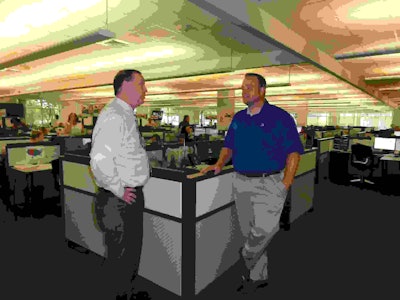 Richard Cribbs, CFO, and Doug Schrier, VP of continuous improvement, on the operations floor of CTG in Chattanooga, Tenn.
Richard Cribbs, CFO, and Doug Schrier, VP of continuous improvement, on the operations floor of CTG in Chattanooga, Tenn.Covenant Transport deployed a mobile driver app in October, 2015. Management opted to use a commercial product from Pegasus TransTech called Transflo that comes with a number of features to simplify driver workflow. The product allows carriers to wrap their own custom features into the app as well.
From his office window, Doug Schrier has a view of the equipment yard at Covenant Transportation Group (CTG) in Chattanooga, Tenn., where approximately 150 trailers are parked in rows.
As trucks move through the yard, it’s obvious which drivers use the CTG Mobile app. Those who don’t slowly pass by in search of assigned trailer numbers to pick up. Drivers may spend up to 15 minutes looking, says Schrier, vice president of continuous improvement and project management for CTG.
Drivers that use the app go immediately to their assignment to hook up. They have seen the exact location of the trailer on the yard in a Google Map by using the trailer locating feature in CTG Mobile.
Drivers can use dispatch messaging and document capture tools as well to send images of proof-of-delivery and compliance documents to the office. The app pays for itself by reducing the cost of drivers using truck stop scanning services, he says.
On a weekly basis, as many 80 percent of Covenant’s 4,000 drivers use CTG Mobile, he says, and the company receives 65 percent of all paperwork electronically from the app.
CTG continues to develop custom features for CTG Mobile. In addition to the trailer location feature, a driver scorecard is a popular custom feature, and the scorecard will soon be tied with a rewards program.
“Every employee wants to know how well they are doing,” he says.
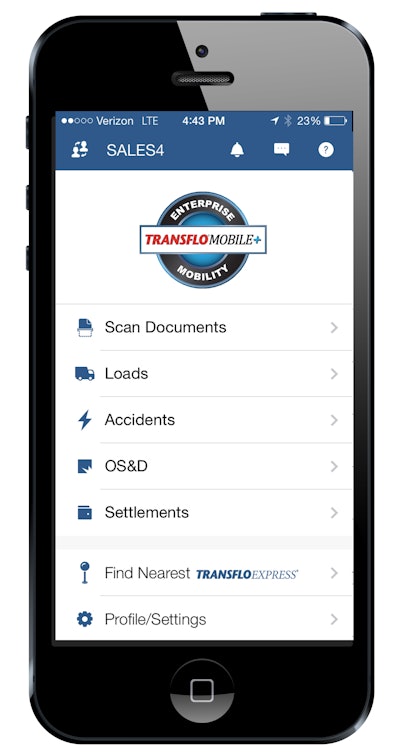 CTG uses a privately branded version of Transflo Mobile from Pegasus TransTech with custom-developed features.
CTG uses a privately branded version of Transflo Mobile from Pegasus TransTech with custom-developed features.The scorecard gives drivers a daily ranking within their peer group. Each group is no more than 100 drivers who are in the same business segment, such as dedicated, with similar job tenure.
“The smaller the group size, the more control they feel they have to get to number one,” he says.
One metric in the scorecard pertains to route compliance. The metric shows drivers their mileage variance from planned navigation routes. Through the scorecard, drivers can provide feedback as to why they varied from a route. The feedback is used by management to create better routes and ensure drivers are getting paid for every legitimate mile, he says.
The scorecard will soon include fuel metrics for behaviors that drivers can control, such as idling, rather than overall mpg, he says. Overall, the strategy of CTG Mobile is to give drivers an easier way to do their work, he says.
“Any time you remove frustration it removes turnover,” he says. “One of the biggest benefits of the mobile app is that we solicit feedback and ideas through surveys. Drivers give us a bunch of great feature requests. We are trying to meet all of them.”
Schrier will be presenting on these and other technologies CTG uses to keep drivers engaged in a CCJ Webinar on May 11th. To register, click here.
Expanding driver workflow
In the summer of 2016, Riverside Transport converted to the SHIPS billing and settlement system from EBE Technologies.
As part of the conversion project, the carrier added a Connect Mobile Capture (CMC) app from EBE so that drivers could electronically capture and submit trip documents such as bills of lading.
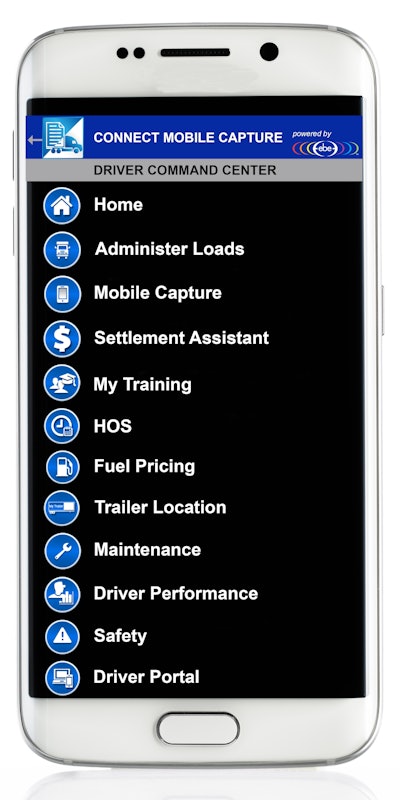 The CMC mobile app from EBE Technologies links to a variety of web-based driver tools.
The CMC mobile app from EBE Technologies links to a variety of web-based driver tools.“I felt comfortable with the workflow,” says Brian Hedge, IT director for the Kansas City, Mo.-based fleet with 450 trucks and 1,100 trailers. “It is easier to use things that come with pre-built integrations.”
The CMC app is integrated with the SHIPS system from EBE and with Riverside’s enterprise software from TMW Systems. When loads are assigned to drivers, the loads are automatically listed in CMC where drivers are able to capture and index images of trip documents.
The SHIPS system sends automatic notifications to drivers through the CMC app for any missing paperwork before the Riverside’s weekly cutoff date for payroll and settlements. Overall the app has made it easier for the company’s drivers to get their paperwork in on time, which in turn has enabled the company to speed its billing cycle by a full day, he says.
Hedge is considering an optional module from EBE that will allow Riverside’s drivers, 75 percent of whom are owner-operators, access to an online portal to store and access images of their business and personal receipts.
Partner integrations
Suppliers of enterprise mobile apps see an opportunity to bring in third-party applications and give drivers a single sign on experience for all of the technology they use for business.
Pegasus TransTech recently announced its Transflo Connect partner platform that expands third-party software integrations with Transflo Mobile. Cat Scale is one example of an early Transflo Connect integration.
Rather than install a separate mobile app from Cat Scale on their phones, drivers at Covenant use the CTG Mobile with embedded functions from Cat Scale’s own mobile app. The functions allow drivers to view and capture their weight measurement records as they cross Cat certified scales.
Pegasus also offers Transflo Telematics through the Transflo Connect partner platform. Announced last year, Transflo Telematics is an enterprise telematics system with features that include ELD-compliant driver logs, vehicle and driver performance reporting.
“We are trying to build everything we can into one app so that drivers can manage their entire workday,” said Rick Bradberry, chief marketing officer of Pegasus TransTech.
The Transflo Mobile app has in-motion restriction technology that allows fleets to configure the app to automatically disable certain features while a vehicle is moving.
EBE Technologies plans to release an icon-driven menu interface for its CMC mobile app. The new interface, called Command Center, will expand the app beyond document capture to give drivers a “single window into all functions,” says Cindy Nelson, vice president of marketing and business development.
Those functions will include one-click access to any web-based driver management application their fleets use from the EBE SHIPS platform that include payroll and settlements, driver safety, compliance, online training and performance scorecards.
The Command Center can include integration with third-party applications and will give drivers notifications for missing work, such as a DVIR inspection report, she says. Additionally, all of the SHIPS web-based driver management applications are getting a new responsive design to optimize the interface for any size of device and web browser, she says.
“It is always evolving. There is never an end point,” Nelson says of EBE’s mobile app strategy.





